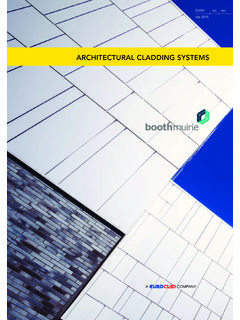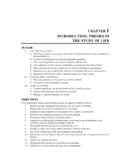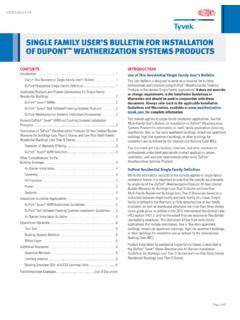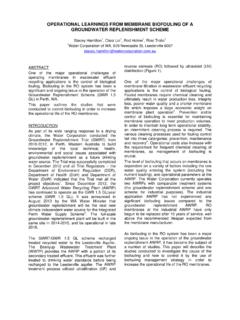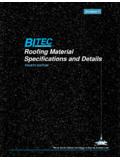Transcription of Putting the R (Value) in Roofing - BECOR
1 Parsons Brinckerhoff Halsall Putting the R ( value ) in Roofing Putting the R. ( value ) in ofing In This Presentation, We Will Cover: Brief History of Roof Insulation: The Rise of R Values Insulation Properties Insulation types: Characteristics Advantages, Disadvantages and Challenges Regulations The Future Rise of Insulation Brief History of Roof Insulation 19th century, wood roof decks Steep slopes to shed water Early 1900s, evolution to more diverse buildings Architectural needs =. Structural Engineer solutions Result of structural changes = greater building design flexibility The Advent of Low-Slope Roofing Steel and concrete revolutionized building design Roof structures began to flatten into low sloped roofs Weight of concrete decks limited designs Introduction of lightweight deck alternatives: lightweight gypsum fluted sheet metal decking (most common).
2 The Advent of Low-Slope Roofing The Roofing membrane needed to be supported over the spans of fluted sheet metal decks. Low performance insulation boards were introduced to meet this need. These include: Wood Fibreboard Perlite Vermiculite Glass fiber The 1970s Energy Crisis Over time, interior building climate needs and loads increased (air conditioning and heating). OPEC oil embargo of the 1970s and energy crisis increased building operating costs, forcing development of standards for buildings 1975: first version of ASHRAE model energy-efficiency standard for buildings, Standard 90. New insulations and solutions were introduced: Phenolic foam EPS.
3 Polyisocyanurate Lightweight insulated concrete Spray Polyurethane foam Insulation Properties Per CRCA, roof insulation needs to have: Dimensional stability;. Firmness to withstand installation traffic (compression strength);. Uniformity of thickness;. Convenient, equal size panels;. Shear strength; and Compatibility with other elements in the roof system. Other Insulation Properties Consider also: Warping / cupping under field performance;. Fire resistance / combustibility;. Acoustical properties;. Sustainability (manufacturing, field performance and beyond);. and Stability of R value performance in different climates (temperature, humidity, etc.)
4 Conventional Roof Assembly In conventional roof assemblies, the insulation is installed below the roof membrane and can be exposed to different products and conditions which may be detrimental to them during the construction phase. Examples of these include: Solvent based adhesive and primers Hot mopping asphalt High temperature from torches The type of insulation chosen must be able to resist these conditions or a suitable protection panel must be installed over the insulation before installing the membrane. Inverted Roof Membrane Assembly (IRMA) or Protected Membrane Roofs (PMR). In an IRMA/PMR system, the insulation will always be exposed to water as the insulation is installed above the roof membrane.
5 The insulation needs to have minimal water absorption characteristics. The only type of insulation suitable for this is extruded polystyrene. Some hybrid roofs include insulation below the membrane and above the membrane Insulation Types Characteristics, Advantages, Disadvantages and Challenges Wood Fibreboard Perlite Board Glass Fibre Expanded Polystyrene Extruded Polystyrene Phenolic Cellular Glass Polyisocyanurate Stone Wool Spray Polyurethane Foam Lightweight Insulating Concrete Wood Fibreboard Introduced in US markets in 1928. Wood based product Interlocking cellulose fibers bonded together by heat, pressure and asphalt resin Boards limited to approximately 25 mm thickness; thicker boards glued together Wood Fibreboard Some Advantages: Some Disadvantages: Economical Low R- value per thickness Local manufacturing Vulnerable to moisture Relatively hard and can be Risk for mould (organic used as an overlay board layer material).
6 To protect the underlying insulation Manufacturing process with high water contents = in-situ Available in tapered boards roof membrane blistering Increased weight versus other insulation boards: ISO, EPS. Perlite Board Introduced in US markets in 1958. Composed primarily of expanded perlite with reinforcing cellulosic fibers and selected binders Mineral based insulation Top surface sealed with an asphalt emulsion coating Perlite Board Some Advantages: Some Disadvantages: Economical Fewer manufacturers Stable R- value and fire resistance Low R- value Can be used as an overlay board Can collapse and rot when wet, layer to protect the underlying thus offering no more insulation protection to the insulation below.
7 Dimensional stability Needs surface coating to Could contain high recycled content prevent excessive absorption of = environmental product asphalt during the installation process High Density: install directly over a Could contain high recycled wide flute or metal deck application content = unstable product? for spans up to 2 " and resists damage from construction and maintenance Glass Fibre Insulation Composed of inorganic glass fibers Used in commercial Roofing systems since 1941. Surfaces faced with a glass fiber reinforced, asphalt kraft paper Glass Fiber Insulation Some Advantages: Some Disadvantages: Stable R values Not readily available Dimensionally stable Costs: production, handling Will not expand with heat or swell Manufacturing and transport costs when exposed to moisture = less competitive than EPS / ISO.
8 Flexible and chemically inert Soft underfoot = impression of wet substrate = fools people Flexibility will allow the insulation to conform to minor deck irregularities Thermal barrier over steel roof decks: adds fire-resistance Can manufacture tapered panels Expanded Polystyrene (EPS). Rigid closed cell foam plastic Formed from plastic polymer Moulded into blocks, processed into sheets (flat or tapered). Types 1, 2 and 3 from less dense to denser materials. Expanded Polystyrene (EPS). Some Advantages: Some Disadvantages: Lightweight Will absorb water No chemical blowing agents (CFC, Vulnerable to petroleum products HFC, HCFC) results in a more stable (solvents, adhesives, coatings, R value over time separation sheets, hot asphalt).
9 Which will soften and collapse Very cost competitive versus other boards boards Will shrink and warp when Cut easily to suit site conditions exposed to high temperatures (75C+/170F+). Non-nutritive: It has no food value Susceptible to foot traffic damage and will not support the growth of and damage during installation insects, parasites or animal and plant life Combustible Inert to a wide range of chemicals Extruded Polystyrene (XPS). Rigid Closed cell foam Low water permeability Low vapour permeability Known as type 4 insulation Can be made more dense to support greater weights for placement under planters, high traffic areas etc.
10 Extruded Polystyrene (XPS). Some Advantages: Some Disadvantages: Resists water absorption = Vulnerable to solvents, hot Installation as part of a PMR asphalt, and high / IRMA roof assembly temperatures (early installation underside BUR =. Low water permeability major failures). Low vapour permeability Costs = limited use above roof membranes Can be made more dense to Use in PMR roofs requires support greater weights ballast = system weight (beneath planters, etc.). Phenolic Foam Manufactured from about 1974 to 1994. Found in Roofing systems since 1982. Catalyst blend of organic sulfonic acids Phenol is a weak acid that is soluble in water.



